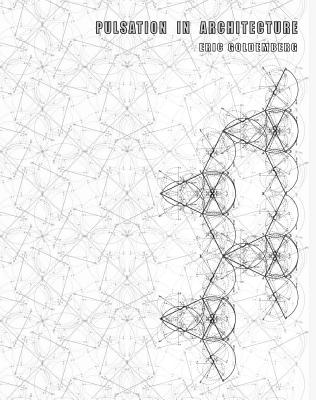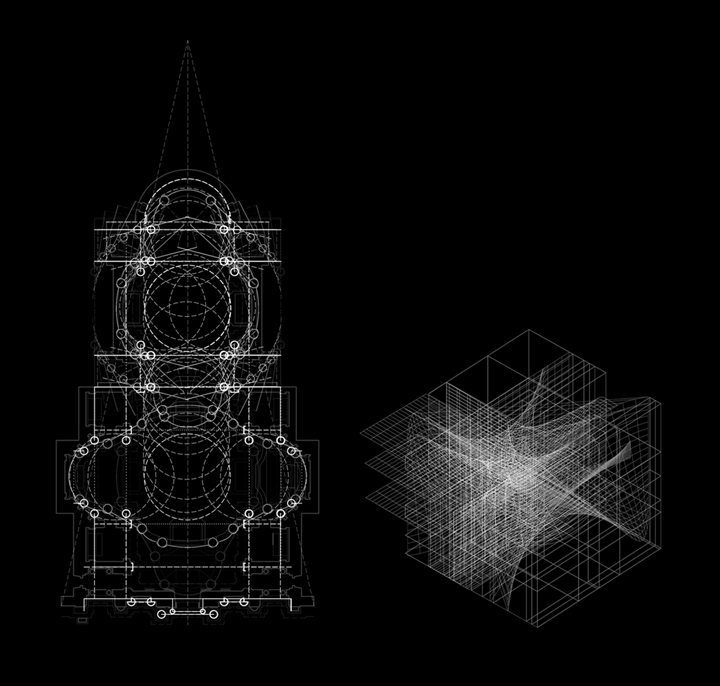
"Carlo Rainaldi’s Post-Historical Suspension: Anticipating
Cartopological Space" Essay publication by Pablo Lorenzo-Eiroa in
Pulsation in Architecture by Eric Goldemberg.
This essay relates Rainaldi's space to the spatial continuity of
Borromini and the spatial articulation of Palladio, critiquing
the relationship between Renaissance and Baroque.
Pulsation in Architecture highlights the role of digital design
as the catalyst for a new spatial sensibility related to
rhythmic perception. It proposes a novel critical reception of
computational architecture based on the ability of digital
design to move beyond mere instrumentality, and to engage with
core aspects of the discipline: the generative engine of digital
architecture reinvigorates a discourse of part-to-whole
relationships through the lens of rhythmic affect. There is a
paradigm shift in spatial perception due to the intense use of
computational techniques and the capacity to morph massive
amounts of data in spatial patterns; rhythm plays a pivotal role
in the articulation of the topology of buildings, generating the
atmospheric character that induces moods and throbbing
sensations in space. Pulsation introduces the fundamental
animate capacity of living form and reshapes our perception of
architectural space across the multiple scales of a project,
from digital inception to fabrication. An emerging thread of
rhythmic sensibility loosely binds a survey of contemporary
design practices, including contributions by Peter Eisenman,
Jeff Kipnis, Greg Lynn, UNStudio, Preston Scott Cohen, Reiser +
Umemoto, Asymptote, Ali Rahim, Hernan Diaz Alonso, Ruy Klein,
Gage / Clemenceau, NOX, Evan Douglis Studio, kokkugia, and MONAD
Studio.
Table of Contents:
A — ACKNOWLEDGEMENTS
B — FOREWORD
Eric Goldemberg: Pulsation in Architecture
C — CONFERENCE RECORD: Digital Pulse in Architecture
Session1:
Conference Introduction: Adam Drisin
Ali Rahim / Contemporary Architecture Practice (Introduction:
Eric Goldemberg)
Jeffrey Kipnis: The Geneology of the Vector Primitive in Recent
Architecture (Introduction: Eric Goldemberg)
Q & A with A. Rahim and J. Kipnis
Session 2:
Marcelo Spina / PATTERNS (Introduction: Alfredo Andia)
David Ruy / Ruy Klein (Introduction: Alfredo Andia)
Eric Goldemberg / MONAD Studio (Introduction: Alfredo Andia)
Q & A with J. Kipnis, M. Spina, D. Ruy, E. Goldemberg
Session 3:
Ferda Kolatan / su11 architecture + design (Introduction: John
Stuart)
Hernan Diaz Alonso / Xefirotarch (Introduction: John Stuart)
Perry Hall (Introduction: John Stuart)
Q & A with J. Kipnis, M. Spina, D. Ruy, F. Kolatan, E.
Goldemberg, H. Diaz Alonso, P. Hall
D — RHIZOMATIC PULSE
Benjamin H. Bratton and Ed Keller: Actually We Found More Than
One Pulse, Sir…
Mark Foster Gage: Architectural Form and the Subjugation of
Concepts
Eisenman Architects / Peter Eisenman
EMBT/Enric Miralles – Benedetta Tagliabue
Greg Lynn FORM / Greg Lynn
RUR Architecture / Jesse Reiser + Nanako Umemoto
Asymptote Architecture / Hani Rashid + Lise Anne Couture
NOX / Lars Spuybroek
Preston Scott Cohen / Preston Scott Cohen
UNStudio / Ben van Berkel + Caroline Bos
Archi-Tectonics / Winka Dubbeldam
KOL/MAC / Sulan Kolatan + William MacDonald
Evan Douglis Studio / Evan Douglis
SPAN / Matias del Campo + Sandra Manninger
Gage / Clemenceau Architects / Mark Foster Gage + Marc
Clemenceau Bailly
Bureau V / Peter Zuspan + Stella Lee + Alexander Pincus
Cmmnwlth / David Boira + Zoë Boira Coombes
Karim Rashid / Karim Rashid
AUM Studio / Ed Keller + Carla Leitão
kokkugia / Roland Snooks and Rob Stuart-Smith
Minimaforms / Theodore Spyropoulos + Stephen Spyropoulos
General Design Bureau / Ciro Najle
Armando Montilla: Digital Nouveau: Revisiting the Vector,
Systems of Symbiosis and the Nouveau Materiality
Pablo Lorenzo-Eiroa: Carlo Rainaldi’s Post-Historical
Suspension: Anticipating Cartopological Space
Michael Young: The Limits of Control
Juan Azulay: Notes for Five Coordinates to the Seam, A five-act
play
E — AFTERWORD
Eric Goldemberg: The Singularities of Rhythmic Affect
F — INDEX
CARLO RAINALDI’S
POST-HISTORICAL SUSPENSION:
ANTICIPATING CARTOPOLOGICAL SPACE,
ESSAY BY PABLO LORENZO-EIROA

Brief of
the essay:
Based on
an projective architectural analysis of Carlo Rainaldi’s
Santa Maria In Campitelli, this essay reveals how
topological displacements may critique a departing type
in a synthetic solution between opposites, promoting tension
through spatial pulsation, polyrhythm and other spatial
bodily affections. The aim is to develop a draft for a
manifesto to critically suspend the continuous state of
pendulum revolution in architecture history, between the
establishment of a canon and its reactionary dialect,
identified by Wölfflin’s Renaissance and Baroque categories,
by proposing a non-dialectical a-historical synthesis that
is able to attack a long lasting metaphysical project.
On the
other side, this essay questions the unrecognized striation
of digital interfaces infer in the constitution of form in
topological displacements, topological surfaces and how they
transform the referential stability of absolutes. Thus
relate the topological surface-space of the object to the
Cartesian frame-space of the medium of representation,
proposing the recognition and institution of a contemporary
state of suspension that demands an hybrid transitory space
between a modern Cartesian space and a potential topological
space, that this essay proposes to define as
cartopological space.